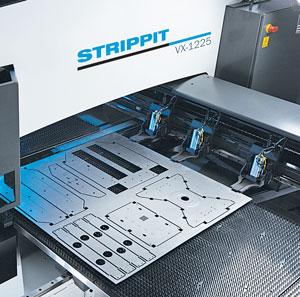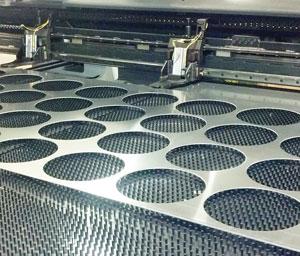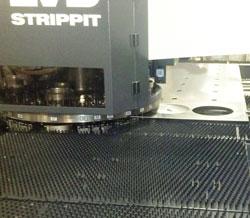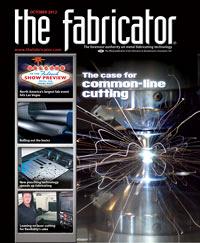Editor-in-Chief
- FMA
- The Fabricator
- FABTECH
- Canadian Metalworking
Categories
- Additive Manufacturing
- Aluminum Welding
- Arc Welding
- Assembly and Joining
- Automation and Robotics
- Bending and Forming
- Consumables
- Cutting and Weld Prep
- Electric Vehicles
- En Español
- Finishing
- Hydroforming
- Laser Cutting
- Laser Welding
- Machining
- Manufacturing Software
- Materials Handling
- Metals/Materials
- Oxyfuel Cutting
- Plasma Cutting
- Power Tools
- Punching and Other Holemaking
- Roll Forming
- Safety
- Sawing
- Shearing
- Shop Management
- Testing and Measuring
- Tube and Pipe Fabrication
- Tube and Pipe Production
- Waterjet Cutting
Industry Directory
Webcasts
Podcasts
FAB 40
Advertise
Subscribe
Account Login
Search
Punching up productivity
New punching press fills a shop's need for speed
- By Dan Davis
- October 8, 2012
- Article
- Punching and Other Holemaking

Figure 1: Mid-West Metal Products knew it was getting a fast punching machine with its new VX-1225, but it was surprised at how quiet it was. The frame design and brush tables play a huge role in that, but Steve Confer, the president of Mid-West Metals’ Industrial Division, said the machine’s hybrid press drive also plays a big part in the machine’s quiet performance. The drive fully engages only as the tooling is about to break through the metal and immediately ramps down after impact, minimizing the full-on ramming that typically takes place on other punch presses. Photo courtesy of LVD Strippit.
"Everybody wants everything yesterday," said Steve Confer, president, Mid-West Metal Products Co., Industrial Div.
Those outside of the metal fabricating business might think Mid-West Metal is in the time machine business after reading a statement like that. Meanwhile, those involved in the bending, cutting, forming, and joining of metal parts know exactly what Confer is referring to: Customers don't care about a fabricator's manufacturing capacity or the calendar when they are in dire need of parts.
That disregard for shop floor reality and the inability to turn back the clock is a byproduct of the current economy. No one is interested in carrying inventory because of cost concerns, and as a result, metal fabricators have to excel at just-in-time delivery of parts.
Mid-West Metal Products, Muncie, Ind., is well-aware of this pressure. It has to balance the demand of customers that operate according to very different schedules. Retail customers might demand fixtures as everyone builds up to high points on the sales calendar, such as back-to-school time or the holidays. HVAC companies require metal components that help them keep up with the seasonal peaks in their production schedules. Meanwhile, OEMs from all across the manufacturing landscape need parts as soon as possible—no matter what the day on the calendar may say.
The metal fabricator is also in a special position because it is in a small fraternity of manufacturers that are adept at working with both sheet metal and wire. Each of its two manufacturing facilities, with a combined 95,000 square feet of production area, has sheet metal and wire processing equipment. (For a mental image of just what a wire-based product looks like, consider the main product from Mid-West Metal's other division, Mid-West Homes for Pets. It's one of the largest pet cage manufacturers in the world.) Mid-West Metal also has a powder coating facility, which puts the fab shop on most short lists for suppliers with both finishing and sheet metal and wire manufacturing capabilities.
Of course, a busy shop typically means business is good, and Confer said such is the case for Mid-West Metal. The family-owned company's 75 employees are working with about 20 temporary employees to keep up with current manufacturing orders. That report mirrors what is happening in the fabricated metal products sector of the U.S. economy; according to the Federal Reserve, that sector reports a capacity utilization rate of 83.9 percent, which is pretty close to the two-decade high of 85.9 percent in 1994-95.
Confer said that Mid-West Metal won a large job earlier this year that was really beyond the means of its punching capacity, so it needed a new precision punching machine. Its two 1500 H/30 Strippits, both about 10 years old, were workhorses, but they were not going to be able to deliver the necessary throughput.
"We just needed higher speed," Confer said. "In today's environment, it's not about long-term capacity. It's about what your fabrication capacity is in two to three weeks."
Pressed to Select the Right Press
Pleased with the performance of its older punch presses, Mid-West Metal traded in one of its 1500 H/30s for an LVD Strippit VX-1225, a 20-metric-ton, 48-station turret punch press and table that can accommodate a 48- by 120-in. blank. It was installed in early May.
Because the fabricator still was dealing with jobs that had tight turnaround times, installation was put on a fast track. By the time the equipment was delivered, the maintenance team had already prepped the cell in which the new punch press would sit. The power lines were dropped in, and the surrounding equipment—the other 1500 H/30, a 4- and an 8-ft. press brake, and a resistance welder—was up and running.

Figure 2: The company punches a lot of aluminum sheet, and the new brush table attached to the punching machine has helped to keep those parts mar-free. Photo courtesy of Mid-West Metal Products Co. Inc.
Confer said the new machine was delivered on a Monday, and that first day was dedicated to bolting everything together and leveling the machine. Tuesday was spent affixing the punch press to the floor. On Wednesday, the operators turned the machine on and began testing out all of the features. On Thursday night and on Friday, it ran production parts.
"The following three weeks after that, it ran over two shifts [each day]," Confer said.
Rated to run up to 530 strokes per minute on 1-in. centers, the punch press definitely met the company's need for speed.
"The turret is very good at high-pierce, high-volume parts. We will try and utilize it as much as we can," said Archie Adamisin, the company's sheet metal engineering manager. "Really, we have found a couple of jobs that we put on the turret where we are able to outrun the laser cutting machine."
For example, a 4- by 84-in. strip cut from 11-gauge cold-rolled steel by a laser is a risky proposition because of potential warping issues as the laser head cuts along the length of the part. Also, because of the light gauge, even with increased wattage, the laser cutting process has to be very deliberate.
How does the new punch press handle the job? Let's just say it's good at nibble punching.
"Now running an 11-gauge part with momentum and mass, we definitely have to turn the speed down. We don't want the machine hurting itself," Adamisin said. "Even though running that job at 75 percent speed, in 3.5 minutes we still get 14 parts. That's pretty amazing."
He added that it would take Mid-West Metal's laser nine minutes to produce the same results. That's a huge improvement for the shop floor team that used to steer most of the high-volume jobs to the laser because the punch presses simply couldn't produce parts as fast.
"It eases up your laser capacity a bit," Adamisin said of the new punch press.
Enjoying the Material Savings
The Mid-West Metal manufacturing team is also finding that the new punching machine (see Figure 1) is helping it save material by eliminating scrap. It was not a big concern with the older equipment, but when a fabricator can save a piece of 4- by 8-ft. stainless steel from the scrap bin, it's an action that deserves to be recognized.

Figure 3: Mid-West Metal’s new punching press has a double-track turret with four standard, 3.5-in., auto-indexable stations. Photo courtesy of Mid-West Metal Products Co. Inc.
Manual repositioning is a thing of the past. The punch press is equipped with three programmable work clamps that can be relocated while the machine is running. The work clamps can be positioned automatically on the X carriage and individually relocated to a new position within the part program. As a result, the blank is rarely out of position. This also helps to reduce or eliminate "no punch" zones, which further opens up the entire blank for usage.
"There are also safety zones built into it so you don't punch over a clamp," Adamisin said. "So the VX is very forgiving when it comes to the safety of the machine. It won't let you hurt it."
In another example of material savings, Confer referenced the small wires that protrude from the tooling station. Those "whiskers," as Confer called them, help the machine detect when thin-gauge material starts to curl up during the punching process; if one of the wires comes into contact with the material, the tooling station will come to a dead stop, avoiding a crash and sparing the sheet metal from the scrap heap.
"It also has sheet removal detection," Adamisin said. "So the sensors in the clamp know if there is a sheet of material in there or if there is not. If a sheet moves in a clamp, it shuts the machine off."
Even something as basic as a brush table (see Figure 2) is a much-welcomed feature, especially compared with the older metal table with the roller balls that was attached to the 1500 H/30. Now operators don't have to worry about incidental scratches on parts that need to be mar-free.
Tackling Tooling Changeover
While the machine's high speed was the feature of most interest to Mid-West Metal, the company has found the quick tooling changeover to be of benefit as well. The tooling station (see Figure 3) has quick-release clamps, whereas the older machine required a bolt to be loosened and removed before a tool could be pulled out. Adamisin said that it takes about 15 minutes to change out tooling, compared to about 45 minutes that it took on the 1500 H/30.
Adamisin added that he is working with the machine operators to come up with a common tool load for the VX-1225. If the punching jobs are devoid of forming applications, Adamisin said it is quite easy to settle on that tooling setup. However, because of the new punch press's versatile turret layout, tooling changeout can be accommodated quickly for those forming jobs.
In the end, whether punching speed or tooling changeout, it's all about time (see Figure 4). Even the longtime operators in the punching department recognize that.
"When you see that carriage coming at you, it's a little intimidating because you don't hear it coming. But it's coming," Adamisin said.
It's not quite at the speed necessary to deliver parts yesterday, but it's fast enough to make same-day or next-day delivery an everyday possibility.
Mid-West Metal Products Co. Inc., 3142 S. Cowan Road, Muncie, IN 47302, 888-741-1044, www.midwestmetal.com

Figure 4: Punching machine operators have found that using the trap door to feed parts to a conveyor slows down the overall punching speed of the machine, as it has to wait for parts to exit the brush table area, but they also are seeing significant increased productivity because shop floor personnel no longer have to shake parts out of a skeleton and then worry about grinding the edges to remove the microtabs. Photo courtesy of Mid-West Metal Products Co. Inc.
About the Author

Dan Davis
2135 Point Blvd.
Elgin, IL 60123
815-227-8281
Dan Davis is editor-in-chief of The Fabricator, the industry's most widely circulated metal fabricating magazine, and its sister publications, The Tube & Pipe Journal and The Welder. He has been with the publications since April 2002.
Related Companies
subscribe now

The Fabricator is North America's leading magazine for the metal forming and fabricating industry. The magazine delivers the news, technical articles, and case histories that enable fabricators to do their jobs more efficiently. The Fabricator has served the industry since 1970.
start your free subscription- Stay connected from anywhere

Easily access valuable industry resources now with full access to the digital edition of The Fabricator.

Easily access valuable industry resources now with full access to the digital edition of The Welder.

Easily access valuable industry resources now with full access to the digital edition of The Tube and Pipe Journal.
- Podcasting
- Podcast:
- The Fabricator Podcast
- Published:
- 04/16/2024
- Running Time:
- 63:29
In this episode of The Fabricator Podcast, Caleb Chamberlain, co-founder and CEO of OSH Cut, discusses his company’s...
- Industry Events
16th Annual Safety Conference
- April 30 - May 1, 2024
- Elgin,
Pipe and Tube Conference
- May 21 - 22, 2024
- Omaha, NE
World-Class Roll Forming Workshop
- June 5 - 6, 2024
- Louisville, KY
Advanced Laser Application Workshop
- June 25 - 27, 2024
- Novi, MI































